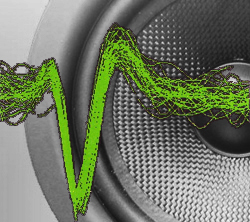
If all-pass filters or FIR (Finite Impulse Response) filters are used on any of the pass bands, the process can be a bit more difficult because the phase response must be matched independently.
If this is the case, the phase response must be inspected as well to insure that it matches the phase response of the target transfer function.
If these types of processing are not used, the response of the filters will be minimum phase.
This means the phase response follows the magnitude response, and vice versa.
Applying delay on the outputs also needs to be looked at a bit differently.
It’s preferred that this be measured and verified to be correct in the time domain.
If so, it doesn’t need to be considered further.
I’ve found the following procedure to work very well in being able to match the output of a DSP to a target transfer function:
1) Set up the signal flow of the DSP (if applicable) so that it is identical to that to be used with the loudspeaker system.
2) Zero all parameter settings so that the DSP becomes a straight wire with the AD and DA conversions. This needs to be done so that the latency may be accurately measured and compensated (removed from the measurement) by the measurement system.
3) Measure each output of the DSP to verify that they all have the same latency. This should be viewed in the time domain. If the latency is not the same on each output, re-check the “zeroing” of all the parameters for the different channel(s).
4) Use this measured latency to set the receive delay of the measurement system so that the latency will not be present in the subsequent transfer function measurements. (Receive delay is what this is called in TEF. It may be called something different for other measurement platforms.)
5) Set the DSP parameters to the values specified by the manufacturer of the loudspeakers that the DSP will be used to drive.
6) Measure each output of the DSP with no, or a very large, time window setting for the measurement system. For these electrical measurements windowing is not needed.
7) Compare the measured response of the DSP with the target transfer function for each output. If the curves do not match, the value of the parameters on the DSP must be adjusted until they do.
Getting the curves to match is the important thing.
Once they do, the loudspeaker should perform according to its intended specifications when driven by that transfer function.
Note that individual pass band delay (if used) will result in a phase response that may rapidly decrease at higher frequencies.
This may be used to assure that the delay is set correctly if it was not verified in the time domain previously.
If the manufacturer’s transfer functions do not include this in their measurement, the receive delay for that pass band should be increased by the value of the delay for that pass band. Doing so will effectively remove the delay from the transfer function measurement.
Alternatively, the delay for each pass band may be set to zero, temporarily, while the above measurement procedure is carried out. Following this procedure will assure that all measured data will correctly capture the magnitude and phase response of the DSP being tested and can be compared to any other device measured with a similar procedure.
Happy tweaking! Just take the time and care to do it right.
Charlie Hughes heads up Excelsior Audio Design & Services, a consultation, design and measurement services company based in Gastonia, NC.
